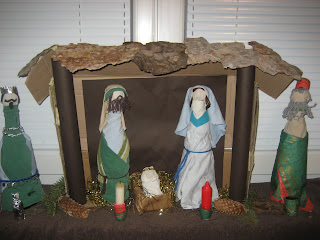Recently, I forced myself to confront reality, the reality that since our marriage, my husband has exhibited the gradual onset of liturgiophila...indeed I would have to admit he now is a qualified, bona fide liturgiophile*. I can't say I have much hope of ever reversing this condition. The most I can do is to share a list of symptoms, documented from experience, so that other unsuspecting Catholic wives can accurately diagnose and cope with the condition in their spouses.
Your liturgiophile may exhibit some, all, or additional symptoms. Rest assured, the exhibition of one or two does not necessarily warrant a diagnosis of liturgiophila - it is the confluence of many (or additional) symptoms, sustained over a significant period of time that decisively indicates the condition.
Thus, and with no further ado,
You might be married to a liturgiophile if...
..."Holy" is his standard response to "How was Mass, dear?"
...the New Liturgical Movement and Fr. John Zuhlsdorf are daily reads AND bookmarked.
...two of the family bookshelves are reserved for his "liturgical collection".
...the big purchases he negotiates with you for are tailored cassocks and embroidered surplices.
...the Ceremonial of Bishops is the most frequently consulted reference work in the house.
...you receive a mantilla for Valentine's Day (thank you, Fr. Z)...and the offer of a chapel veil in a color of your choice for Mother's Day so as to coordinate with various outfits.
...over supper, he reveals that he knows "ambones" is the plural of "ambo".
...he can advise an instituted acolyte on serving as subdeacon.
...he knows and discusses the use of obscure pontifical vesture, and repeatedly calls for the return of the use of the cappa magna by the Bishops, (and the triregnum by the Pope).
...(in that vein), you knew that the first thing to mention was the return of the papal fanon when he asked you about the broadcast of the recent canonizations...and you weren't surprised when he made the former the subject of a facebook post.
...(and still proceeding on this theme) his opinion on which particular style of Roman Chasuble is the best (it's a toss up apparently: the Philip Neri or the Italian style) qualifies as romantic conversation.
...his friends guffaw knowingly when new acquaintances ask his opinion on Children's Liturgy.
...your spouse frequently debates the merits of Fortescue vs. O'Connell with random clergy.
...and while he owns both texts, his modus operandi is WWFS (What Would Fortescue Say?).
...he is determined to have a son named "Gregory", and your adamant refusal to even consider "Pius" is near occasion for argument.
...he spends hours researching to find you free PDFs of out-of-print books on ecclesiastical embroidery.
...your friends come for a casual cup of tea, and leave wide-eyed, asking, "How does he KNOW all this stuff about the Mass??"
...he knows which clerics can only wear wool, and which can wear silk.
...Gammarelli's is top of the "tourist" list when your family travels to Rome.
...and he insists on taking a photograph to document the visit:
*As a qualification, though I am not overly naive on this point, I would generally expect the clergy to possess a working knowledge of and love for the liturgy and all things liturgical. I am therefore identifying symptoms of this condition as manifested in the laity.









